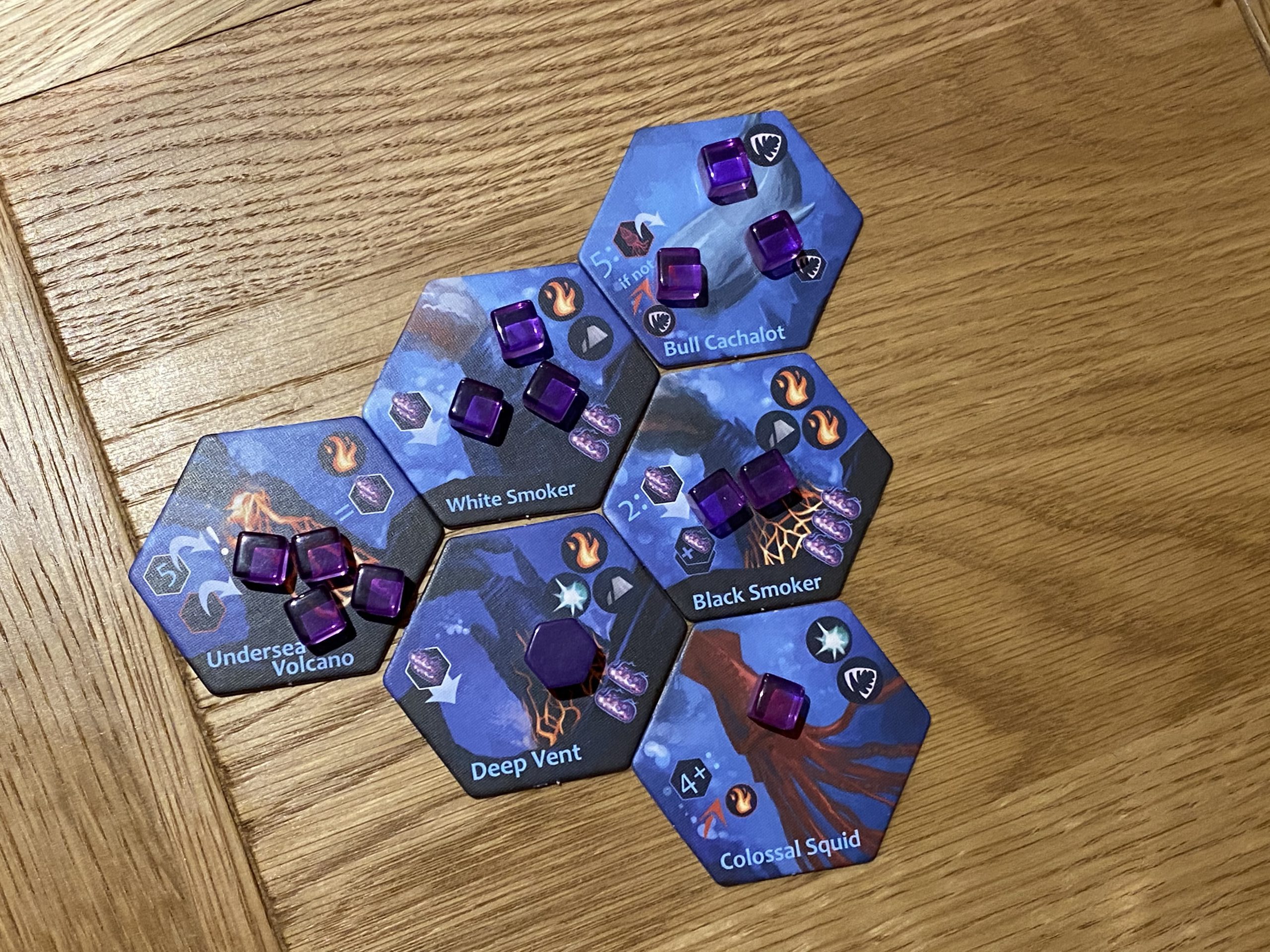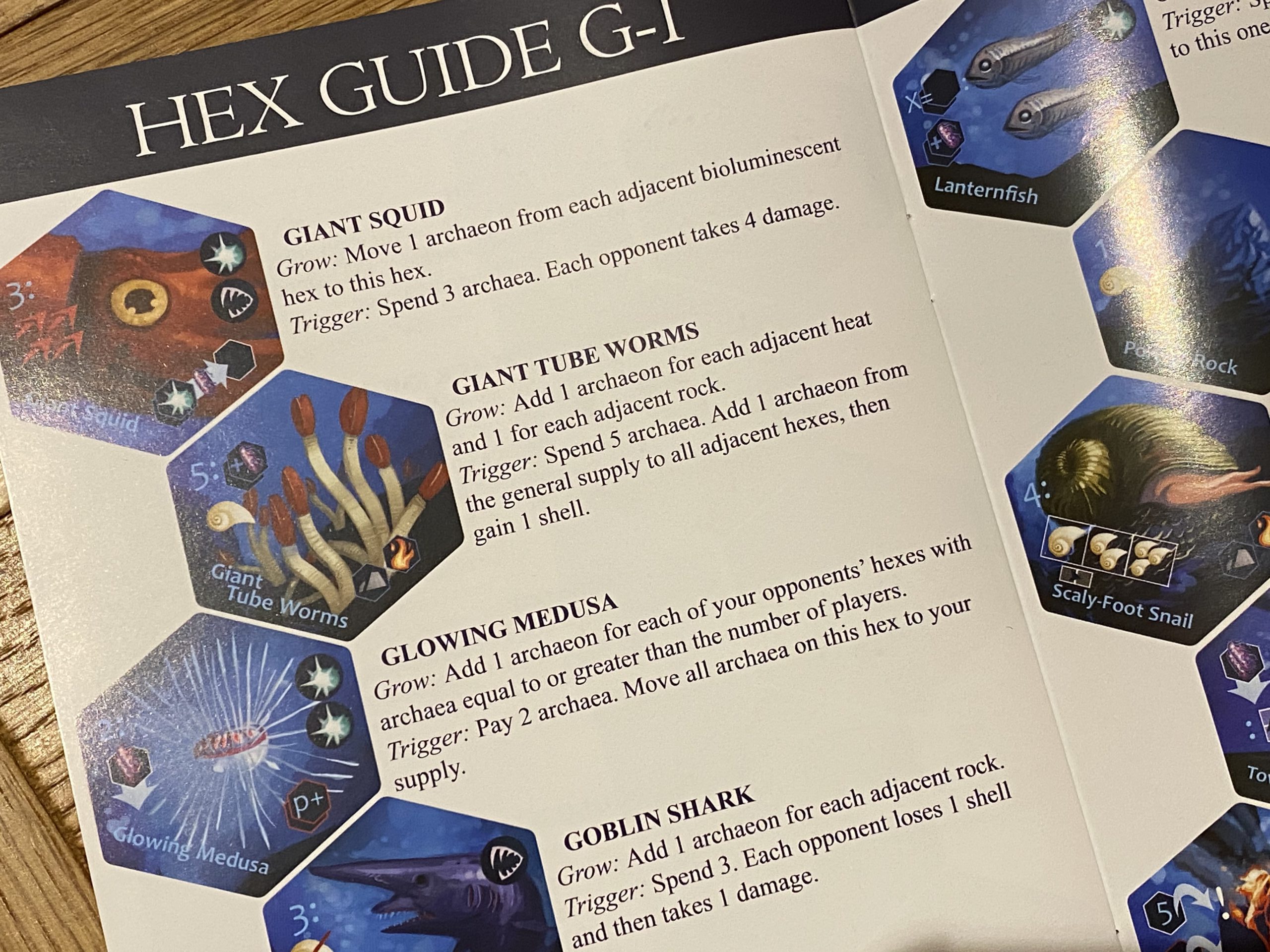Deep Vents is a small box game that delivers a big bite of value
I’ve said on many occasions that what I love most about board games (and video games, to be fair) is that they transport me to distant realms, far away worlds and, in the case of Deep Vents, deep, deep under the sea. This latest title from Ryan Laukat and Red Raven Games is a small box game, but it’s a good deal heavier and more thoughtful than you might expect.
At first glance, the components for Deep Vents seem pretty straightforward, and the slightly muted colour palette across the hexagon tiles, plastic shells and plastic “archaea” tokens sets a mysterious, foreboding tone. There are simply too few of these pieces for you to imagine that Deep Vents is especially complex, but the challenge – and indeed the game — comes from the icons on each hexagon tile.
Before I get too far into some of the specific details, I should first explain how Deep Vents plays, since the setup and turn structure are fairly straightforward. Each player begins the game with one tile called “Deep Vent” from which the life in their particular section of the deep ocean will sprout. Depending on player order, each player will also receive a number of archaea tokens.

In the centre of the table, the players will place a face up stack made up from the remaining hexagon tiles. During setup, five of these tiles will be dealt in a row extending outwards from the main stack. On each of their turns, the players will first draw one of these hexagon tiles and add it to their ecosystem. To do this, they may choose the tile furthest from the stack for free, or they must place one archaea on every tile up to the one they choose, if they go closer to the stack.
With their chosen tile in hand, they will then place it into their ecosystem by lining up any flat edge against another, existing tile. As I’ll explain next though, this placement is everything, because in the next phase of their turn, that player will resolve each of their tiles one by one, beginning with the top left (from their perspective) and moving left to right, row by row. I’ll come back to this in a moment, as this is where those symbols show their true meaning.
The final phase of a player’s turn is simply to rebuild the tile market by sliding each tile one step away from the stack, to fill whatever gap was made. If this was the first (free) tile, then all the others will move over one and a new tile will be revealed, whilst if the tile drawn was from the middle of the line, only the tiles that were closer to the stack will move into the empty space, and a new tile will be drawn.
Now if we step back briefly to the phase where a player would resolve the tiles in their ecosystem, this is where Deep Vents really comes to life. The player will begin, as I mentioned, with the top left tile and will choose to either Grow or Trigger each hex. When they Grow, they’ll look at the bottom right corner of the tile, and add an amount of archaea as indicated depending on the kind of tile it is.
When a player triggers a hex, something else will happen — and this can vary quite a bit. Different hexes will show creatures or environmental features such as volcanoes or anemones of various kinds. As a result, the trigger effect can vary from something quite passive and specific to that player, or to something a lot more confrontational – including an attack on all the other players that will cost them archaea.

The key concept to understand about Deep Vents is that archaea in your personal supply are worth a victory point each, whilst those on the hex’s are worth half a point each. A big part of the game therefore is in using the grow abilities to develop archaea on the hex tiles, then using neighbouring trigger effects to either transfer archaea from your hex’s to your supply, or to take it away from other players.
If this sounds like it might result in some direct confrontation, that’s because it does and unlike in most other games, when a player runs out of archaea in their personal supply as the result of an attack, they must take a shortfall token and ten archaea tokens from the bank. If you ever have two shortfall tokens and need to take a third, you are actually eliminated from the game.
Now, given that a game of Deep Vents ends when each player has nine tiles (their starting tile plus eight more) then a player being eliminated is unlikely – but not impossible. I was quite surprised to see this mechanic in a Ryan Laukat design, since he usually endeavours to be very inclusive, but I do really like this part of Deep Vents.

There’s a sense when playing this game that you are building a “survival of the fittest” kind of landscape, and each new hex is as powerful as the next, either because it generates loads of archaea itself, or because it has a powerful attack effect or trigger that can change up your strategy. Whenever I watch programs about the deep oceans, I never cease to be amazed about the way in which life can thrive with such small margins — and that is reflected well in Deep Vents.
Sure, not everyone will love the amount of direct confrontation, but it’s a key part of the game, and it’s important for bringing the theme (such as it is) to life. The engine building potential of the hex tiles makes for some very complex gameplay, and the sheer number (and complexity) of the different icons takes some learning, but a freely available printout certainly helps.
Overall, Deep Vents is an unexpectedly deep (excuse the pun) small box game, with some ethereal and unusual but very nice components, and an engine and combo building system that is simple to learn, but very, very complex to master. It’s a great two player game because of the direct head to head nature that it provides, whilst in multiplayer it becomes a bit more frantic as each attack hits every player, and elimination becomes more likely.
You can pre-order Deep Vents on Red Raven Games’ website.
Comments are closed.